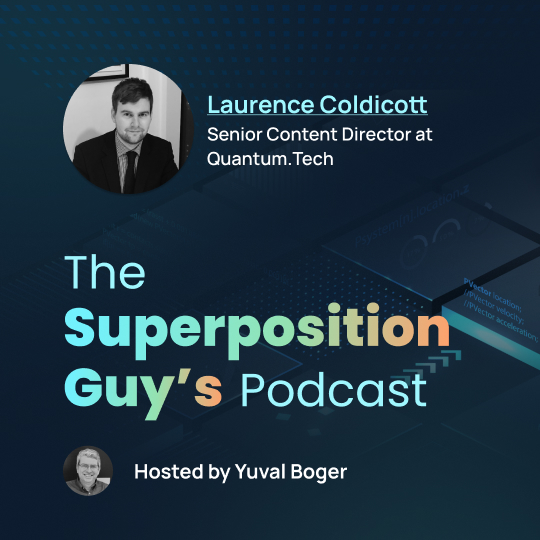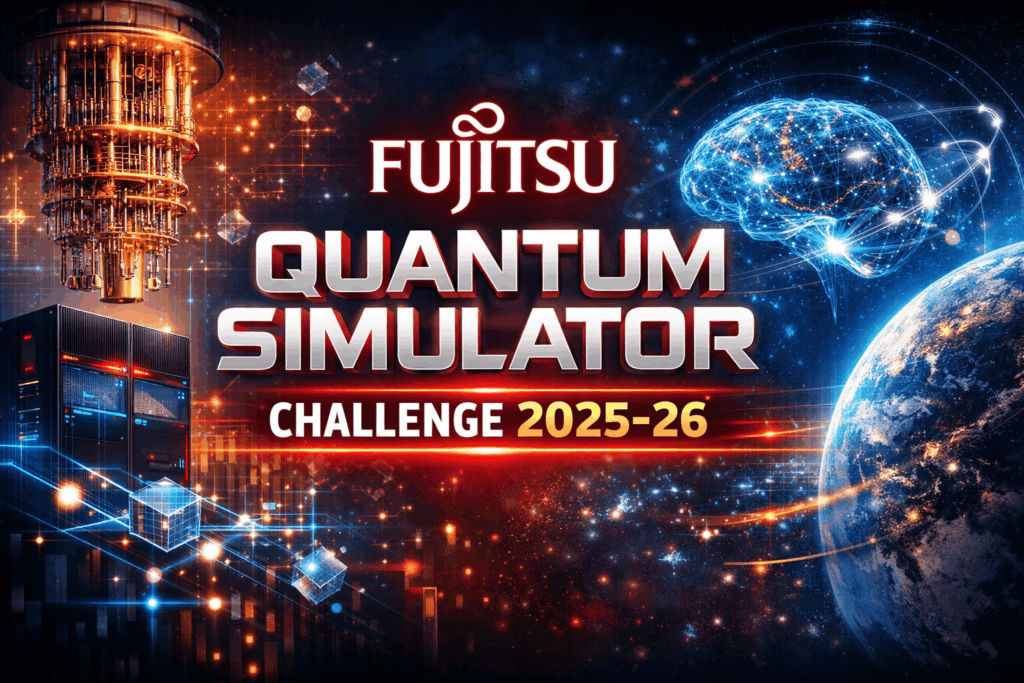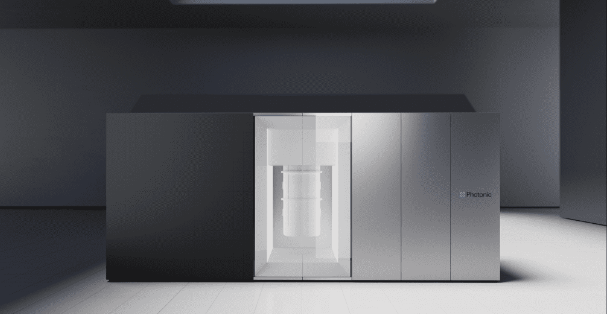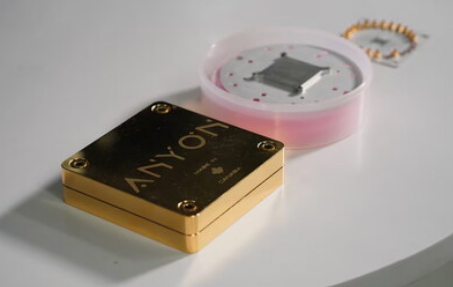“The Superposition Guy’s Podcast”, hosted by Yuval Boger, Chief Commercial Officer at QuEra Computing
Nick Farina, CEO of EeroQ, is interviewed by Yuval Boger. They discuss EeroQ’s unique approach to building quantum computers using electrons on helium with a CMOS chip substrate, a technology researched for over 20 years but revisited by Farina’s co-founder at Caltech. Farina outlines the company’s journey from its founding in 2016, its strategic focus on hardware, and plans to release a functional prototype soon with a goal of achieving 10,000 qubits by 2026. They also explore the technical advantages, future plans, and the company’s commitment to quantum ethics. Farina highlights challenges such as the funding climate and potential negative impacts of quantum technology, and endorses neutral atoms and silicon spin qubits as alternative modalities.
Listen on Spotify — here

Full Transcript
Yuval: Hello Nick, thank you for joining me today.
Nick: Thank you so much, I appreciate you having me on the show.
Yuval: So who are you and what do you do?
Nick: So my name is Nick Farina and I am the CEO of EeroQ. We were started in 2016, incorporated back in 2017. So we’ve been around for quite a while now in terms of quantum computing industry startups. We were originally spun out of Michigan State University. We’ve been a little bit stealthy then and since.
But the first five years of the company was really a joint venture between myself working with some partners on providing investment funding to do sponsored research at Michigan State University. And ironically I came from a software background and our focus is 100% on hardware. So I’m a lifelong entrepreneur, I’m an angel investor and I came to quantum somewhat by accident.
I’ll keep the story brief but I was on the board of directors of my co-founder’s wife’s theater company in 2011 and I just became so fascinated. At the time he was a PhD student, later did a postdoc at Caltech and then got that professorship at MSU. But I became really enchanted by how magical quantum mechanics are and just not even thinking about quantum computing originally. I was just really mystified by the world of ultra low temperature experimental physics.
And then to keep the narrative rolling then in 2022 we felt that we were in a position to get to a 10,000 range quantum computer within five years. And I’ll mention we had also brought on a CTO, Steve Lyon, who is a professor at Princeton. And Steve changed our trajectory in a few ways that we can discuss later but especially focusing on a CMOS compatible architecture. And the company itself does electrons on helium.
So there will be a lot to unpack there because on the one hand it sounds exotic and new. On the other hand it’s been in the literature since 1999. So it’s very old but also very new at the same time.
Yuval: So I understand that the company makes quantum computers or makes technology by which you can make quantum computers. Help me focus on that.
Nick: Absolutely. So we make quantum computers. So we are building a quantum computer that as with many other companies we envision having both on-prem offerings as well as cloud offerings.
There are as you know between seven to 10 different ways to build a quantum computer and electrons on helium using a CMOS chip as your substrate is a unique way out of those seven to 10. So one thing that makes EeroQ unique is that we are our only competitors. So electrons and helium has to work. And I’m happy to describe how that system works in a minute. But we are our own lane.
And the reason that we chose this particular qubit modality is because it’s been researched theoretically and experimentally for over 20 plus years now. So we know a lot about the system. And similar to technologies like neutral atoms, it’s a next generation technology that is earlier stage in its development but at the same time offers some really compelling advances and advantages once someone is able to get it to work.
Yuval: I gather from the description of the CMOS substrate that the idea is that once you have this working as you describe then it’s easy to scale because CMOS chips are super well understood. There are so many places and you can make them and so the scaling part is almost solved. I know it’s far from solved but it’s almost solved once you have the basic building blocks in place. But I’m curious, you mentioned that you are in your own lane. Is that because others are not aware of this technology? Is that because of IP protection? Why wouldn’t you have additional competitors?
Nick: That’s a classic question to answer so I’m happy to answer that one. But first I’ll say that you did just give our sales pitch regarding CMOS which is essentially what we call it has been building a quantum computer in reverse. So no one has ever performed a two qubit gate with this system because we think that’s actually the easier part and that’s the part that we’re working in now.
But what we’ve done is the CMOS now has gone well beyond theory. So we work with a foundry called SkyWater up in Minnesota and SkyWater produced for us a chip where we can control ensembles of 2,432 electrons. So it’s similar to these large scale demonstrations in neutral atoms where you don’t necessarily have 6,000 qubits but you have an array of atoms that can be controlled. So we’re at a similar stage there where we’ve proven the CMOS can work with the liquid helium. So we’re a scaling first company.
And the reason now to answer your other question is there’s a few reasons that we are in our own lane. The first is that the way that quantum computing had developed in the United States very broadly is that in the early 2000s there was quite a bit of money provided by the government to fund different approaches. And some of these approaches were successful like superconducting circuits and ion traps at their very early stages. And then as a result, a lot of investment began to pour into those areas because they had shown promising early results.
Electrons and helium didn’t work. So when there were attempts made in the early 2000s is when the experimental work began, we just didn’t have the mastery of the properties of electrons and helium. We didn’t have the equipment needed. So now for example, we can work with partners out there, vendors like Bluefors, like quantum machines that provide tools that were not available at all when this was first experiment I started.
So then what happened was because it wasn’t a system that was able to get up and running quickly, there was a drought of funding for it. So it wasn’t pursued as heavily as it might have been and therefore it lost some traction and ground. And then where we came in is during my co-founder Johannes’ time at Caltech, he basically put two and two together and dusted off an old paper. And he said, “Well, at Caltech, everyone’s talking about quantum computing.”
He got very familiar with the other modalities because he had been a condensed matter physicist generally at ultra-low temperatures, not focused on quantum computing until he went to Caltech. And there he said, “Look, everyone’s talking about the pros and cons of these technologies, but I remember a paper in Science from 1999 that proposed electrons and helium, which is an expertise of his, that really wouldn’t have any of these flaws where you could have exceptionally long coherence times, you could have all-to-all connectivity, you could have mobile qubits on the surface of the helium.
And the fun scientific fact is that electrons floating above helium are attracted to their own image beneath the helium surface. So the trapping is natural and this provides for immense potential for scalability and no requirement for modular interconnects.” So for those reasons, we decided that even though this technology is really early, it needs to get the same type of shot that everyone else did because this could be a really compelling second generation technology.
And it’s taken a long time. Once we brought it back initially with some funding from myself and my friends and then later from venture capital. So our lead investors, B Capital Group, they’re the strategic venture arm of the Boston Consulting Group. And a few other reasons that we are able to stay in this lane is that it’s a very, very small field. So there’s probably 10 or so people in the world who are truly experts at electrons on helium and about seven of them work at EeroQ.
So we were able to create a moat around talent, a moat with IP and a moat with a head start to actually build a scalable computer. And that’s the reason why we have this very, very deep moat. Now that doesn’t mean someone is not going to start one of these companies as we become more successful. But we do feel that we have a pretty strong moat around it.
Yuval: This is liquid helium, right? So this would be about four Kelvin and the electrons would swim around in the helium?
Nick: Yeah. So we’re running around 10 millikelvins, so quite cold. And what happens is, so it’s superfluid helium and you have your bottom layer is your CMOS chip. And then we put a layer of bulk helium at the bottom, which crawls the walls as superfluids do. And then that coats that CMOS chip and the electrodes on the chip. And then we use a tungsten filament, just basically a light bulb, to spray electrons into the system.
And then control and readout is done very similar to superconducting circuits using CQED. And that’s what the system looks like. And if your listeners want to compare it to another technology that exists that’s better known, it would be silicon spin qubits. The advantage being that the comparison being that we’re both using single electrons as qubits and we’re both a CMOS compatible system, but with electrons on helium, that little additional layer of helium provides a protective barrier so that the qubits don’t get stuck in the silicon and are therefore exposed to all the defects of silicon like trapped charges, valley splitting, and so forth.
Yuval: When can I use one? How far are you from demonstrating or showcasing to the outside world this computer?
Nick: Well, watch this space over the next couple of months. We’ve got some pretty exciting news coming out regarding the basics of the system. We have a functional prototype of the scaling system in our engineering facility. We’re based in Chicago. When can you use it? I would say aggressively sometime next year. We’re working on building a simulator for it as well. Being able to use it in a simulation environment, the answer would be much sooner.
But 2025 and 2026 are really when we see this system fully come online in working with both cloud vendors and potentially, depending on the demand, on-premise installations. One advantage I’ll mention there is that because there’s no need for modular interconnects, if someone’s looking for an on-prem quantum computer, all they need to do is get one chip from us and a Bluefors. That’s the entire setup. In that way, it has the ability to have a very small footprint, similar to neutral atoms in that way.
Yuval: Can you give us a hint on how many qubits?
Nick: Yes, I can. Our goal is going to be 10,000 qubits at some point in 2026. How exactly we distribute that, again, the split between on-prem and cloud remains to be seen. But the whole purpose of the system, as you already noted, is that we can go from our upcoming two-qubit gate to simply adding it to a scaling layer that we have already proven out works with liquid helium and with our system. So that’s what enables us to leapfrog so quickly and scale so quickly.
And then from there, because it’s CMOS, in terms of going beyond 10,000, it’s just a matter of making more features in the CMOS.
Yuval: What can you tell us about coherence time or clock speed or anything that people use to measure the performance of existing systems?
Nick: Yeah, absolutely. I will note, of course, this is all theoretical because we have to build the system and have it out there. But the reasons that we’re excited about this system are that you can get well over 10 seconds of coherence time. Three nines in terms of key fidelities. We have all-to-all connectivity, which allows you, in addition to mobile qubits, both of which allow us to run the state of the art in error correction, whatever that may be.
Clock speed is something that will change due to variations. So we don’t usually give a precise number on that. And let’s see, I covered all-to-all connectivity. And the other key advantage in terms of metrics and benchmarking is that, well, this falls a little bit out of the scope and more into the advantages, is we’re able to control all the electrons with a single voltage. So in terms of actually being able to practically operate the machine in terms of wiring, you’re able to do with far fewer wires than with some other systems.
Yuval: That point about fewer controls is also an important selling point of neutral atom systems. In neutral atom systems, the qubits move around with optical tweezers. How do they move around in your system?
Nick: So we use RF pulses. So again, it’s very similar, it’s sort of a mixture of superconducting circuits and silicon spin qubits in some ways. But we use a pretty standard circuit-quantum electrodynamics toolkit to control and read out the qubit states. And what’s nice about the qubits, I keep mentioning mobility, but it’s a really important point.
The fact that they’re mobile on the surface allows us to, if we have any bad qubits, simply move them around and reconfigure. Because a lot of efforts having bad qubits and getting around them can be quite a challenge. So the mobility there is also something that is a significant part of the control of the qubits. And then the electrons themselves, before they’re moved into the operation zones, to the gates, we store them in little microchannels that are etched onto the chip.
And then they’re taken to the operation zones where we apply voltages and do computation in the very near future.
Yuval: Tell me more about the company. You mentioned when you were founded and how this started, you mentioned your lead investor. How many people are you and what are you looking for?
Nick: So we’re about 15 people now. We are very proud to be located in Chicago, which I think is, we had a national search for a headquarters, given that we were all over the place. We had people, of course, in Princeton, in New York City, and Michigan as well. So I was originally from Chicago, but we chose Chicago not because of that, but because of the talent pool there. So we moved into, we have about a 10,000 square foot engineering lab. And it was actually a fun challenge to find because we needed something very, very stable to avoid any fluctuations of the liquid helium. And as you mentioned, it can slosh around. So we are headquartered in an old locomotive headlight factory.
One thing that makes the company unique is that we have a pure 100% hardware focus. So we view ourselves as a fabless semiconductor company. And this allows us to be very capital efficient because at the end of the day, we don’t need to build out our own fabrication, our own machinery around that. We simply are, we design the chips and then we can have them produced by third party foundries.
Now that being said, we don’t have to wait around, I shouldn’t say waste, but we don’t have to wait around for wafers to come back in order to test and prototype new designs. So we do local fabrication here as well to test and iterate on a weekly basis on new chip designs.
One other thing that makes the company unique is that we’ve been focused on quantum ethics and responsibility since before it was cool. So back in 2018, we put out a white paper written by a PhD from MIT in philosophy about the ethics and governance of quantum computing and why we should get ahead of that at that time. So we stay very focused on hardware, but we also have a focus on policy and making sure that quantum computing is something that is a force for good in the world. As you know, it’s a dual use technology, so there are good and bad things you can do with it. And we’re definitely on our way to making a quantum computer and we’re pretty confident in our path now and we want to make sure now that it feels inevitable that it’s used properly.
Yuval: So all these hardware things, not bad for a software guy.And as an entrepreneur, what keeps you up at night? What are you worried about?
Nick: Well, as an entrepreneur, you’re always up at night because there’s an endless amount of things to worry about. But one thing I don’t worry about is the quality of our team. I love the people that we work with and the technological effort. I certainly worry about the funding climate in general for quantum computing and where we’re going to see. Now this has begun to change because even though the general funding climate is in a bit of a downturn now, we’ve seen strong investment in quantum computing. So that keeps me up a little bit less.
We are not raising money now, but you always have to be thinking about that as a CEO. And finally, I’ll say the potentially negative consequences of this technology do keep me up a little bit at night. Thinking about, again, because we have a very high level of confidence that we’re going to be able to build this computer. And we also have confidence in other pathways. And I don’t even want to call them competing pathways because I think there will be room for multiple different qubit pathways to exist and to be successful.
So knowing that, having such a bullish perspective on us being able to achieve quantum advantage perhaps quicker than some folks think, that certainly keeps me up at night a little bit. But I’m very proud of what we’re building here.
Yuval: Speaking of alternative modalities, so if there were no electrons on helium, which modality would you endorse?
Nick: I would endorse neutral atoms and silicon spin qubits. I would do a dual endorsement because I think they both have key advantages. Silicon spin qubits, they both have a lot of brilliant people working on them. And silicon spin qubits, you have the CMOS, with neutral atoms, you have a small footprint, and you have a system that seems like it can scale in a way that others can’t.
Again, we’re focused 95% on scalability. The type of two qubit gates we’re working on are very well understood. So for us it’s about how we can make this scalable in addition to having high quality. But those are the two that I would, and I’m not just saying this because you’re involved in the neutral atom world, but we’re big fans of those two. But we want to see everyone succeed.
Yuval: One measure that we forgot to talk about is gate fidelity. What are you looking to achieve in the near term in terms of single or two-qubit gate fidelity?
Nick: We think three nines is something that we can get to. That will be the first design perhaps, but by the time within the period of two years or so, we think we can get there. Especially given that we’re the combination of using the spin state of the electron magnetic field there, as well as the intrinsic purity of the environment. So we’re not afraid to say that in terms of fidelities that we would predict that.
Yuval: And last hypothetical, so if you could have dinner with one of the quantum greats dead or alive, who would that be?
Nick: That’s a great question. I would say someone who I know from quantum Twitter, Jens Eisert. I don’t even know if I’m pronouncing his name correctly. Could be Jens. But I’m going to give a shout out to him. A lot of the work that he’s been doing lately has been really, really interesting, particularly at the conversion of quantum computing and artificial intelligence, which is something that I don’t say lightly because I know we don’t really know if there is a speed up there, but he’s been doing really great work in that area and that’s something I know very little about. And he’s accomplished quite a bit. I would put him down actually.
Yuval: Nick, thank you so much for joining me today.
Nick: Thank you so much. It was really a pleasure and always appreciate the show.
To subscribe to the audio podcast, please Spotify here

















